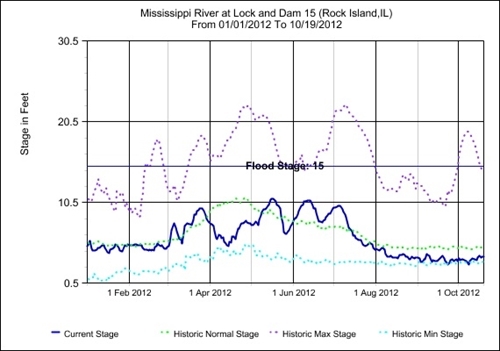
Greg Swanson
Low water level at the Moline surface water intake on the Mississippi River
 By Greg Swanson
By Greg Swanson - January 24, 2013
Experiencing Drought is a series of guest profiles by public works officials on the impacts of drought on northeastern Illinois communities. This is the second in the series, view other posts from the Experiencing Drought series. For more information, please contact Abby Crisostomo at acrisostomo@metroplanning.org.
Municipality: Moline, Ill.
Water Source: Mississippi River
Issue: Water systems taxed by effects of drought are undervalued and underfunded
Outcome: Water users need more outreach and education to properly value and pay for clean drinking water
Consider the following questions and quick responses: Where does water come from? The faucet. Where does food come from? The grocery store. Where does electricity come from? The wall socket. Where does gasoline come from? The gas station. Our minds respond in this way, in part, because we are preoccupied with the myriad of details of our busy lives. The end result is that we are not cognizant of the complex natural cycles and vast infrastructure that supports our daily lives. This is certainly true with regard to food and water.
Our ancestors were pointedly in tune with the sources of their food and water. They had to be or they would not survive. We, on the other hand, generally take our sources of food and water for granted. We tend to think of them in terms of grocery and utility bills, with varying degrees of focus on quality. We generally don’t give enough thought to long-term sustainability and the true value of these precious commodities that fulfill our most basic and fundamental needs.
Illinois communities derive their water supply from various sources, which include Lake Michigan, various rivers and surface water reservoirs, shallow and deep aquifers. The demands our communities place on these finite water resources continue to grow. In 2012, the drought conditions exasperated this concern, as water use went up, while natural recharge of our water resources was greatly diminished.

2012 Mississippi River level at Lock & Dam #15 compared to historic min, max and average levels.
U.S. Army Corp of Engineers
The 2012 drought also impacted other aspects of water supply operations. Water utilities, like Moline, that rely on surface water as their source, encountered significant operational problems with algae blooms and water quality changes associated with the hot sunny conditions. Water utilities relying on aquifers observed significant drops in the subsurface water levels, raising concerns regarding the adequacy of these aquifers in the years that lie ahead. Other water utilities supplies experienced increased distribution system failures, as pumping rates were increased to meet elevated water demand. Such distribution system failures are not surprising, given that many of the water mains in use throughout the state are very old, dating back as far as the mid 1800s.
Collectively, the water supply infrastructure in Illinois is an elaborate amalgam of vast and complicated systems and structures worth billions upon billions of dollars. Unfortunately much of this infrastructure has reached the end of its useful life. Concurrently, water quality regulations are growing more stringent, as scientific knowledge and technology advance. We are confronted with a fundamental need to reinvest in our water infrastructure to ensure our future health and prosperity.
We must raise the shared public awareness and interest in our water systems, if we are to perpetuate the many benefits they bring to our daily lives. Water rate and fee adjustments will be required to fund capital needs. While water users often complain about the cost of drinking water, it is actually a phenomenal bargain. For example, the 2013 cost per thousand gallons in Moline will be $4.46. This equates to $1.07 per ton or less than ½ a penny per gallon depending upon of one looks at it. This water is delivered to our customer taps 24/7, meets and surpasses all drinking water standards, and, if there is a water quality problem, we are legally required to inform all of our customers. This cost is incredibly low for one of life’s much precious needs.
There is a growing need for water appreciation and sustainability throughout Illinois. You can elevate your own water awareness, using some the following simple measures:
- Become familiar with the physical source of your drinking water and participate in efforts to conserve and protect it.
- Contact your water utility to learn more about their operations, infrastructure needs and efforts to ensure water quality and sustainability.
- Participate in community meetings relating to water system issues and concerns.
- Examine how you use water in your home and/or business to identify potential areas where conservation may be possible.
- Consciously savor the many benefits your tap water brings to your life.
Get involved in conserving, sustaining, and renewing the water resources and supply system in your community. As Jackson Browne sings “Oh people look around you. The signs are everywhere. You’ve left for someone other than you to be the one to care.” Collectively, we can work together to address growing water sustainability concerns and transform widespread water apathy into true water appreciation.
Greg is Utilities General Manager for the City of Moline, where he has worked in the public water supply field since 1977. Greg serves as a Trustee for the Illinois Section AWWA and is a strong advocate of public outreach efforts that promote knowledge and appreciation of water system benefits and challenges.